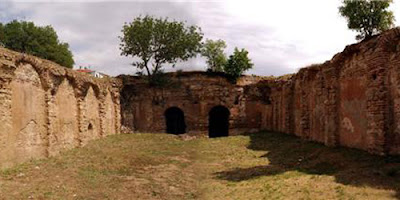
August 13, 2010
Hürriyet Daily News
The Küçükyalı Arkeopark, a large archaeological area on the Asian side of Istanbul, hosts the only surviving Byzantine monastic complex in the city, the head of the excavation team says. The 9th-century complex contains gorgeous marble floors, valuable mosaics and beautiful art objects that she hopes to see in a museum someday.
The only surviving Byzantine monastic complex from 9th-century Constantinople has been uncovered in the Küçükyalı Arkeopark, located on the Anatolian side of Istanbul, the Italian head of the excavation team said Thursday.
“People started out thinking this was a 9th-century Islamic place. When I started doing research here, it became clear that this identification had no good grounding,” said team leader Alessandra Ricci, who noted that some travelers’ accounts dating from the early 19th century mentioned the existence of a Byzantine monastery in the area.
The rich monastic complex, built between 867 and 877, encompasses the church and burial place of Patriarch Ignatios, a prominent figure in Byzantine history who is depicted in the mosaics inside Hagia Sophia.
“There is nothing from the Ottoman period here, not even a piece of pottery. Underneath the modern layers, we’re going directly to Byzantium,” Ricci said, adding that the discovery is a wonderful opportunity for her since she has a great passion for the Byzantine period and it is very rare to find wall paintings from that era in Istanbul.
“We found beautifully decorated marble floors, golden mosaics, wonderful coins and beautiful art objects that deserve to be displayed in a museum,” Ricci said.
The Byzantinist scholar said she decided to conduct the first excavations in the area in order to eliminate the ambiguity about whether the archaeological remains belonged to the Byzantine or Ottoman periods. She received permission from the General Directorate of Monuments and Museums, part of the Ministry of Culture and Tourism, and has been working under the direction of the Istanbul Archaeological Museums since 2008.
The French author Pargoire wrote a study on monasteries on the Marmara seashore that identified the ruins in the area as part of the Satyros Monastery, an identification later supported by Ernst Mamboury, a geometry teacher at Galatasaray High School. In 1959, however, Semavi Eyice published an article in which he identified the complex as a palace built by a Byzantine emperor by the name of Theophilos, in imitation of Islamic Abbasid-period buildings in present-day Iraq, Ricci said. She explained that Eyice was mistaken in his identification as he did not conduct a survey of the area.

In addition to identifying the site as Byzantine, the excavations have retrieved organic residue from the period that are being used to examine patterns of climate change and other aspects of the history of Istanbul. “There was a lot of grain, but no olive trees or vineyards,” Ricci said, emphasizing that the team is also interested in exploring how much the ecological system and the climate have been transformed.
“Every single object taken out of the earth first goes into the washing area and then on to conservation and laboratories,” she said, noting that she plans to take the materials to the specialized laboratories of Koç University, where she works as an associate professor in the archaeology and art history departments.
A team of approximately 50 people, including archaeologists, graduate students and workmen, works under very hard and hot conditions, Ricci said, adding that the team’s just-completed season was very productive compared to 2008, when the Marmaray Tunnel Project absorbed much of the potential workforce.
Ricci said the team would carry out a conservation project in October to preserve the historical trees at the archaeological site, in collaboration with the Maltepe Municipality. “This is not just a dry archaeological site; we need to leave this place as a piece of tangible and permanent heritage,” she said.
Sightseeing tours are being prepared for both local and foreign tourists interested in Istanbul’s Byzantine heritage, Ricci said, adding that she is enthusiastic about sharing the team’s work with future visitors. “I am very grateful to this country because [Turkey] has given me the opportunity to do my research here. These kinds of dreams do not always come true,” she said, adding that she plans to continue her work excavating the complex’s church next year.
Read more here and here.